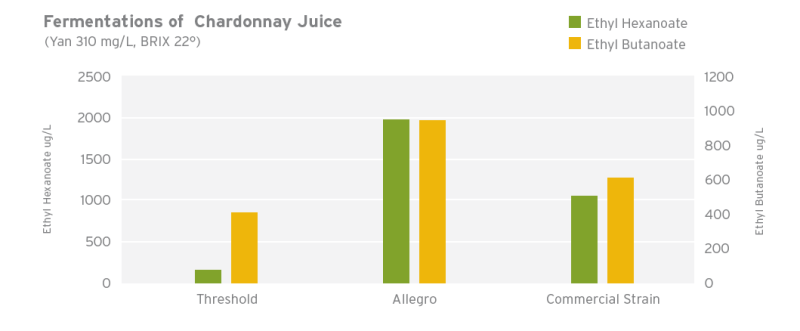Knowde Enhanced TDS
Identification & Functionality
- Ingredient Name
- Food Ingredients Functions
- Ingredients
- Yeast
- Technologies
- Ester Compounds
- Ethyl Butanoate:fruity, flowery, pineapple,blackberry, apple, strawberry
- Ethyl Butanoate:papaya
Features & Benefits
- Labeling Claims
- Food Ingredients Features
- Product Highlights
Allegro pairs perfectly with moderate climate Chardonnay and Viogner, where peach and melon predominates, but it is also an ideal partner with more neutral varietals as Ugni Blanc, Colombard, Pinot Blanc, Chenin or high yielding vineyards. Because Allegro is H2S–preventing, it is the perfect ally for barrel aging on the lees, where Allegro can increase the mouthfeel and texture of Chardonnay, Viognier, Chenin and Semillon without producing H2S off aromas. Allegro is MLF compatible with a moderate nutrients requirement and extremely low production of SO2.
- Recommended Varietals
• Chardonnay
• Viogner
• Ugni Blanc
• Colombard
• Pinot Blanc
• Chenin
• Semillon
Applications & Uses
- Markets
- Applications
- Food & Nutrition Applications
- Rehydration Instructions
- In an inert and sterile container, prepare chlorine-free water at 38-42 °C (100-108 °F) that is 10 times the weight of the yeast to be rehydrated.
- Gently mix the yeast into the water and allow 20 minutes for rehydration.
- After rehydration, begin to slowly add full strength juice into the yeast mixture every 5 minutes to allow for acclimation. Do not decrease the temperature of the mixture by more than 5 °C (9 °F) with each juice addition.
- When the temperature of the yeast suspension is less than 10 °C (18 °F) warmer than the must or juice to be inoculated, slowly add the yeast mixture into the fermentation vessel.
Note: Directly adding dry yeast to the must or juice tank is not advised.
Properties
- Typical Properties
| Value | Units | Test Method / Conditions | |
| Kinetics | Moderate | - | - |
| Optimal Temperature | 15-28 | °C | - |
| Cold Tolerance | 13.0 | °C | - |
| Alcohol Tolerance | 16.0 | % | - |
| Nitrogen Requirements | Medium | - | - |
| Killer Factor | Active | - | - |
| Flocculation | High | - | - |
| Dosage | 0.2-0.35 | g/L | - |
| Conversion Factor | 16.3 | g/L | - |
| Glycerol | 5.0-7.0 | g/L | - |
| Volatile Acidity | Low | - | - |
| Sulfur Dioxide Production | Very Low-None | - | - |
| Hydrogen Sulfide Production | None | - | - |
| Foam Production | Low | - | - |
| Yan Levels Low | 150-225 | - | - |
| Yan Levels Medium | 225-300 | - | - |
| Yan Levels High | 300+ | - | - |
| Inoculation Rate | 0.2-0.35 (1.7-2.9) | g/L(lbs/1000 gallons) | - |
Technical Details & Test Data
- Fermentations of Chardonnay Juice

Packaging & Availability
- Packaging Type

